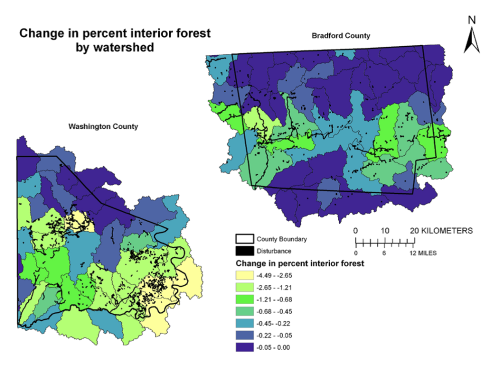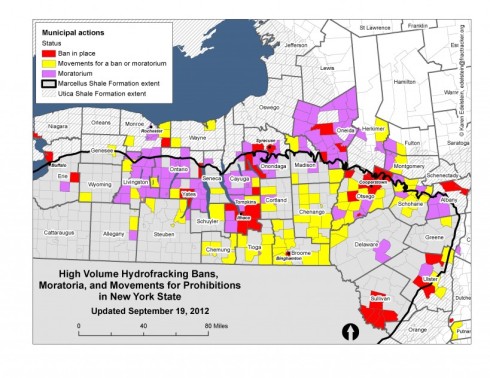While the most important decisions to determine whether and where we might have hydrofracking in NYS will be taken in Albany and at the local-NY municipality levels, what happens in other states has some indirect bearing on the mood and context in which those decisions are taken.
This week, the State of California was sued over hydrofracking. The lead litigant is Earthjustice, and they filed the suit on behalf of the Center for Biological Diversity. Also signed on the suit are Earthworks, the Environmental Working Group and the Sierra Club. Additional environmental groups have also joined the suit. They allege that California has not been following its own laws over the past year, as permits have been issued for fracking. As reported by the (law-firm sponsored) blog Shale Watch:
The lawsuit, filed in Alameda County Superior Court, alleges that California’s Department of Conservation is approving oil and gas drilling permits without requiring preliminary environmental reviews or adequately monitoring possible consequences. The environmental groups are seeking a court order declaring that fracking violates current state law and prohibiting any new permits from being issued without a full analysis of the risks being performed. California currently does not distinguish between fracking and traditional techniques used to extract oil and gas. “The lawsuit is about [making] the state follow existing environmental law and just getting basic information to the public about what projects are being proposed, what potential impacts there are and making sure those impact are mitigated,” said an Earthjustice attorney.
There is, as of yet, only a little support for a ban in the California legislature. But, new regulations are in the process of being drafted, as reported in Reuters:
Given the public scrutiny, new rules are not expected to be finalized until mid-2013, officials said, though a draft set of rules are expected soon. State legislation to halt fracking, however, has so far received little support.
The laws of California frequently influence state law in the rest of the country. It will be interesting to watch this unfold in California.
From the big state of California at the state level, we turn to the little state of West Virginia, at the local level, where a court has held a gas company responsible for paying for a black cemetery they bulldozed while building a road to a drilling site. The details of this case make it so poignant that its impact is likely to extend beyond the rural area where it happened. As reported by the Charleston Gazzette:
Gas drillers who plowed through a cemetery for a historically black coal camp community in 2004 were ordered to pay $200,000 in punitive damages Wednesday, on top of the $700,000 in compensatory damages a Logan County jury awarded a day earlier.
Jurors ruled Tuesday that Equitable Production Co. and subcontractor General Pipeline were reckless when a bulldozer operator desecrated the Crystal Block Cemetery near Sarah Ann….
“This jury has found that Equitable’s reckless treatment of mountain cemeteries will not go unpunished,” said the plaintiffs’ attorney, Kevin Thompson.
If this happened accidentally, you might be able to see how the gas company would contest this. But, the graves were neither inconspicuous nor old– they were marked by headstones, and the last person buried there was put in the ground in 1965. Relatives visited yearly on Memorial Day to tend and neaten the gravesites.
The damage was discovered by James Olbert, whose father, Daniel, is buried there, but it continued while two more roads were built.
Resident Bud Baisden pleaded with a crew member to stop, the lawsuit said, but the worker used racial slurs in describing who was buried there, and the bulldozing continued.
Roughnecks on a mission to frack– and their industry-paid lawyers– respect neither the living nor the dead in the path of their dozers. This time, they at least were assessed a little fine for desecrating the dead.
In Pennsylvania, a Duke University researcher, Rob Jackson, has analyzed data gathered by the EPA about the well water in Dimmock, PA, and concluded that Cabot Oil has polluted people’s wells. It’s important that scientists from outside the EPA analyze the data the agency gathers, as scientists within the agency have often found that their work on this issue has been severely edited by political appointees (see Ian Urbina’s coverage of this). As reported by Bloomberg:
n a 2010 consent order, the Pennsylvania Department of Environmental Protectionfound that 18 drinking-water wells in the area were “affected” by Cabot’s drilling. The company disagreed, and applauded when the EPA cleared the water in Dimock as safe this July. State regulators ruled last month that Cabot could begin fracking seven wells in the affected area of Dimock, ending a moratorium imposed in 2010.
The latest data, which the EPA began to collect early this year, were posted on the agency’s website in response to Freedom of Information Act requests from Jackson, Cabot and others. The EPA submitted the results to its researchers conducting a broader nationwide study about the effects of fracking on drinking water, agency spokesman David Bloomgren said.
Not that this new data is at odds with data already collected and analyzed: the gas in the water wells matches the gas in the gas wells every time its checked. Says Fred Baldassare who was the hydro-geologist at the Pennsylvania Department of Environmental Protection who analyzed the isotopes of methane in Dimock when the state began investigating homeowners’ complaints in 2009, and now owns his own private company testing water:
The molecular and isotopic evidence I saw was that the gas in the water supply looked like the gas in the Cabot gas wells. It’s doing more damage than good to keep denying… Let’s get past that.
Cabot continues to fight taking any responsibility for the damage to peoples water supplies, lives and health. It is as yet unknown how the EPA will respond to analysis of their data by independent scholars.
How do we keep federal agencies accountable? Well, the vast bureaucracy in Washington has a bureau for that; the Government Accountability Office has issued a report, OIL AND GAS: Information on Shale Resources, Development, and Environmental and Public Health Risks. It’s a hefty report, but a review in Ecowatch notes that it
concludes that fracking poses serious risks to health and the environment. The report, which reviewed studies from state agencies overseeing fracking as well as scientific reports, found that the extent of the risks has not yet been fully quantified and that there are many unanswered questions and a lack of scientific data.
I note, just on first perusal of the report, that it clarifies the extent and estimated recoverable reserves, in light of the important new information from the USGS, which slashes previous overinflated claims of industry about the scope and value of the recoverable resources.
The USGS, unlike the politically-vulnerable EPA, seems to be continuing to produce excellent reports without political interference. A recent paper on the impact of gas development on the land use and land cover in two Pennsylvania counties is well worth reading. The authors, Slonecker, Milheim, Roig-Silva, Malizia, Marr, and Fisher, using impeccable GIS spatial analysis, quantify the land directly used up by the drilling and its infrastructure, as well as the fragmentation of the forest environment and its effects on wildlife. If you don’t have the time to read it in full, the one sentence version is:
Agricultural and forested areas are being converted to natural gas extraction disturbance.
And the one-map version is:

As the authors do not determine indirect impacts on agricultural land, we are still left to wonder how this change in the landscape is related to the 18+% drop in dairy production and dairy animals in counties like these over roughly the same time period.
Meanwhile, in Europe, Germany’s Federal Environment Agency and Federal Ministry for the Environment, Nature Conservation and Nuclear Safety have issued a joint report. There are a lot of important conclusions, but, perhaps the most important statement in the press release about the report is:
The experts currently advise against large-scale use of hydraulic fracturing to tap natural gas in unconventional deposits in Germany.
Individual wells, under strictly controlled conditions, may be allowed for research purposes.
Also in Germany, an independent group of scientists have issued a Hydrofracking Risk Assessment paid for, but not directed by, Exxon-Mobil. They found some major risks, as well as minor ones. A good synopsis is available at EcoWatch, along with information about the European Commission’s Environment Directorate-General’s comprehensive report.
Meanwhile, right back here in upstate NY, the Buffalo News contain a report from a local farmer who contends that fracking waste spoil his hay fields, and nobody will do anything about it. So, he, too is suing:
Finally it dawned on me. No one would help me. Not the drilling company. Not the Oil and Gas Association that represents the drilling company. Not my own town government, not even the state agency that gave the driller a license to ruin my hay field.
Now I am buying hay at $8 a bale for my cattle – many times more than the costs to grow my own hay. I have hired a lawyer and I am suing the drillers.
The next time you are tempted to believe the oil and gas industry propaganda, stop by my farm for a dose of reality.
![]() Elected officials from many of these towns, as well as others, have protested the short 30-day comment period offered on the regulations. The move, which was initiated as the holiday season got underway, had too little advance notice for most municipalities to offer comments on the regulations, while still complying with noticing requirements under the Open Meetings Law. The Elected Officials to Protect NY called on the Governor to extend the comment period on the regulations. Even as they did so, environmental groups are continuing to urge individuals and businesses to make multiple comments on the regulations, through such sites as Thirty Days of Fracking Regs.
Elected officials from many of these towns, as well as others, have protested the short 30-day comment period offered on the regulations. The move, which was initiated as the holiday season got underway, had too little advance notice for most municipalities to offer comments on the regulations, while still complying with noticing requirements under the Open Meetings Law. The Elected Officials to Protect NY called on the Governor to extend the comment period on the regulations. Even as they did so, environmental groups are continuing to urge individuals and businesses to make multiple comments on the regulations, through such sites as Thirty Days of Fracking Regs.




